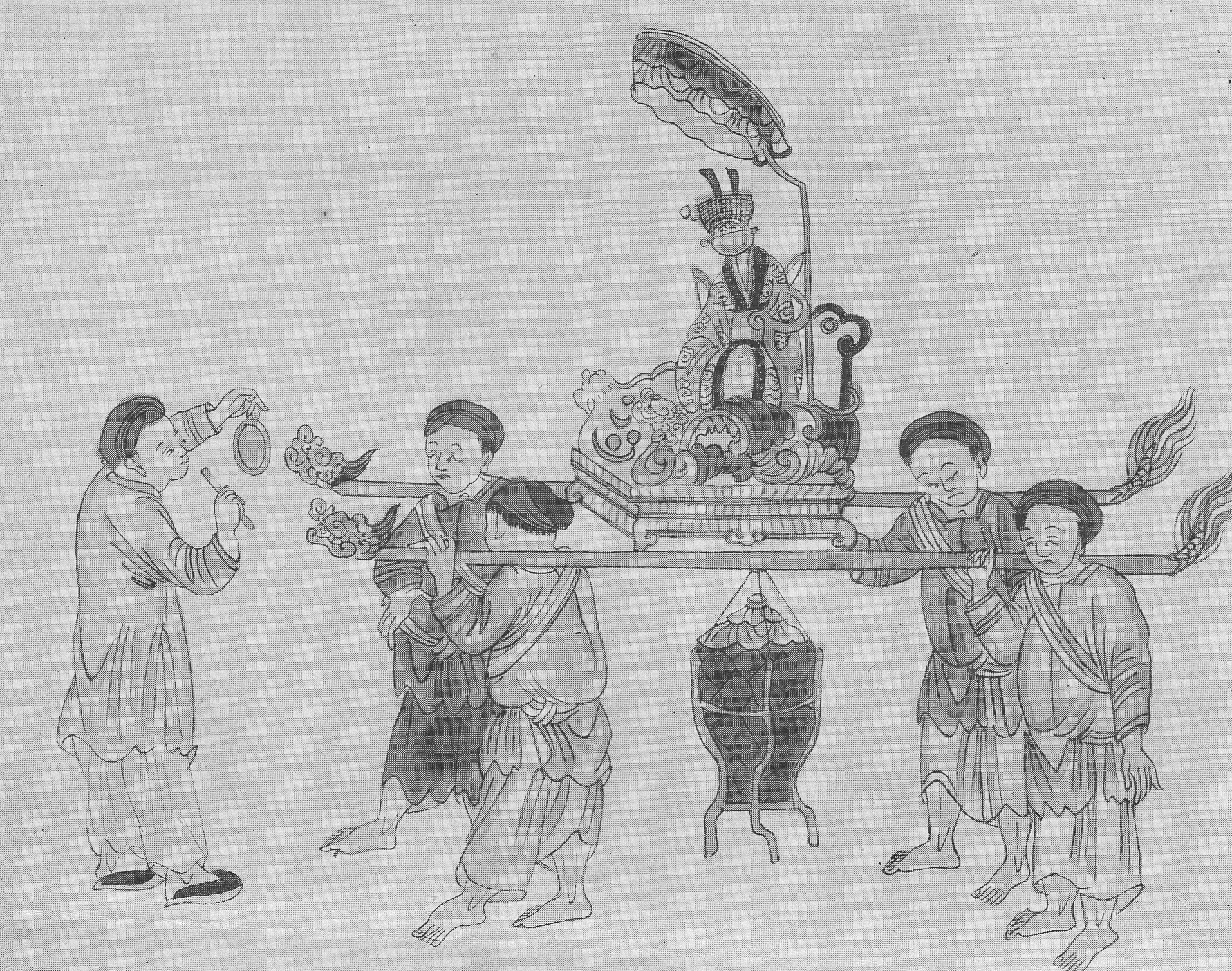Thành Hoàng on:
[Wikipedia]
[Google]
[Amazon]
Thành hoàng ( vi-hantu, 城隍) or Thần hoàng (神隍), Thần Thành hoàng (神城隍) refers to the gods or deities that are enshrined in each village's
 No later than
No later than
File:Vân Côn, rước Thánh qua ao làng.JPG, Ceremonial procession of Thành hoàng in Vân Côn village.
File:Đoàn người đi rước Thánh.jpg, Ceremonial procession of Thành hoàng in Quang Điểm village.
File:Lễ hội Bình Đà.jpg, Ceremonial procession of Thành hoàng in Bình Đà village.
File:Chuẩn bị rước kiệu trong lễ hội làng Triều Khúc - panoramio.jpg, Ceremonial procession of Thành hoàng in Triều Khúc village.
File:Ruocsacthan.JPG, Ceremonial procession of Thành hoàng
Đình
Đình (Chữ Hán: 亭 or 庭) or Vietnamese communal houses are typical of buildings found in Vietnam villages, dedicated to worship the village god, Thành hoàng
Thành hoàng ( vi-hantu, 城隍) or Thần hoàng (神隍), Thần Thành ho ...
in Vietnam. The gods or deities are believed to protect the village from natural disasters or calamities and bring fortune.
Etymology
' is a Sino-Vietnamese word, literally referring to the city wall and the moat that surrounds it. It is also the Vietnamese pronunciation of Chinese ''Chénghuáng'' (orCity God
A tutelary (; also tutelar) is a deity or a spirit who is a guardian, patron, or protector of a particular place, geographic feature, person, lineage, nation, culture, or occupation. The etymology of "tutelary" expresses the concept of safety and ...
), which was adopted from Taoism
Taoism or Daoism (, ) is a diverse philosophical and religious tradition indigenous to China, emphasizing harmony with the Tao ( zh, p=dào, w=tao4). With a range of meaning in Chinese philosophy, translations of Tao include 'way', 'road', ' ...
.
Origin
 No later than
No later than Đinh dynasty Dinh (丁) is a Vietnamese surname. In Vietnam, the surname is spelled Đinh or Đình, but the latter is very rare in Vietnamese.
Notable people
* Andy Dinh, Team SoloMid owner, player
* Dan Dinh, ''League of Legends '' player, brother of Andy ...
, each locality started to worship the mountain and river gods that ruled over a domain which encompassed their village. Later on, the government decreed the deification of late national heroes, righteous officials and loyal subjects, and specific localities were chosen to exalt these gods. Gradually other common folks took up the practice and worshipped their own gods to be blessed with protection and fortune.
Ranking
Generally each village worships only one Thành Hoàng; however, it is not rare to see two or more gods enshrined simultaneously at a village. They are known collectively as Gods of Fortune (''Phúc Thần'').Phan Kế Bính, Vietnamese Customs, Ho Chi Minh City Publishing house, 1990 edition, p.78-79. Even these Gods were divided in three ranks * High ranking gods: famous mountain and river gods, immortals such asThánh Gióng
Thánh Gióng (chữ Nôm: 聖揀), also known as Phù Đổng Thiên Vương (chữ Hán: 扶董天王, ''Heavenly Prince of Phù Đổng''), Sóc Thiên Vương (chữ Hán: 朔天王), Ông Gióng (翁揀, ''sir Gióng'') and Xung Thiên Thầ ...
, Chử Đồng Tử
Chử Đồng Tử (Chữ Hán: 褚童子) is the name of a famous Vietnamese divine being, one of " The Four Immortals" "Tứ bất tử" in traditional Vietnamese mythology. In legends, Chử Đồng Tử appeared on a yellow or golden dragon to ...
whose backgrounds are mysterious and miraculous, and unusually brilliant men such as Lý Thường Kiệt
Lý Thường Kiệt (; 1019–1105), real name Ngô Tuấn (), was a Vietnamese general and admiral of the Lý dynasty. He served as an official through the reign of Lý Thái Tông, Lý Thánh Tông and Lý Nhân Tông and was a general duri ...
and Trần Hưng Đạo
Trần Hưng Đạo (; 1228–1300), real name Trần Quốc Tuấn (陳國峻), also known as Grand Prince Hưng Đạo (''Hưng Đạo Đại Vương'' – 興道大王), was a Vietnamese royal prince, statesman and military commander of Đại ...
.
* Middle ranking gods: whose accomplishments are ambiguous but have been worshiped for a long time
* Lower ranking gods: whose background and accomplishments are ambiguous but are known to bless mortals
Apart from the ranked gods acknowledged by the government, there were villages that worshiped "demons" and "tainted gods" such as the Beggar God, the Serpent God, the God of Lecherousness, and others.
Gallery
Nguyễn Văn Thành Nguyễn Văn Thành (chữ Hán
( , ) are the Chinese characters that were used to write Literary Chinese in Vietnam, Literary Chinese (; ) and Sino-Vietnamese vocabulary in Vietnamese language, Vietnamese. They were officially used in Vietnam ...
in Tân An commune, Thủ Dầu Một
Thủ Dầu Một () is a municipal city of Ho Chi Minh City, located at around . The city has an area of 118.91 km², with a population of 373.105 (as of 2024), and is located on the left bank of the Saigon River, upstream from the city. It ...
, Bình Dương province.
File:Lễ hội1.jpg, Ceremonial procession of Thành hoàng in Nam Trì village.
File:LeHoiLangNghiaThanh.jpg, Ceremonial procession of Thành hoàng in Nghĩa Thành village.
Notes
See also
* Cheng Huang Gong *Tu Di Gong
A Tudigong ( zh, s=土地公, l=Lord of the Land) is a kind of Chinese tutelary deity of a specific location. There are several Tudigongs corresponding to different geographical locations and sometimes multiple ones will be venerated together in ...
* Seonangsin
* Dōsojin
is a generic name for a type of Shinto ''kami'' popularly worshipped in Kantō and neighboring areas in Japan where, as tutelary deity, tutelary deities of borders and paths, they are believed to protect travellers, pilgrims, villages, and individ ...
References
*Phan Kế Bính, Vietnamese Customs, Ho Chi Minh City Publishing house, 1990 edition. {{DEFAULTSORT:Thanh Hoang Vietnamese folk religion Vietnamese mythology Tutelary deities Vietnamese deities Vietnamese gods